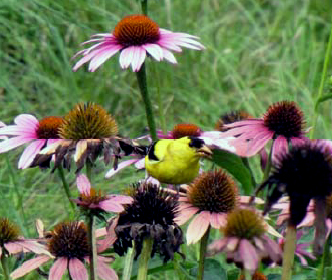Conservation Landscapes

Conservation landscapes are designed to benefit local streams and the Chesapeake Bay by using native plants as a low-cost alternative to traditional landscapes, which use turf grass and ornamental plantings.
Benefits of Conservation Landscapes
- Get a credit on your Stormwater Utility bill for new conservation landscapes!
- A unique, aesthetic beauty.
- Minimized need for mowing, pruning, irrigation, pesticides and fertilization, saving you time when compared with traditional lawn maintenance.
- Typically, half or as little as one-fifth the cost of conventional landscapes.
- Absorption of more stormwater than a conventional landscape.
- Read some common myths about conservation landscapes!
Native Plants Used in a Conservation Landscape
- Are relatively low maintenance and better adapted to local climate conditions than conventional landscapes, resulting in less need for herbicides, fertilizers, pesticides or soil conditioning.
- Help remove suspended solids and heavy metals from groundwater.
- Stabilize soils and prevent erosion.
- Provide food and habitat for local wildlife such as beneficial pollinators (bees and butterflies) and birds.

Some native plants will attract butterflies and birds to your yard.
Installation
- Select an area in your yard; it can be in an existing garden bed, or you can replace an area of lawn or invasive plants. Native plants flourish in local soils — even clay — and working leaf mulch or compost into the soil can improve drainage.
- Select your plants. Landscapes that include trees or shrubs provide the most benefit for water quality and wildlife, but beds of flowering native perennials will attract pollinators like butterflies and bees. We can provide you with information on appropriate plants for a conservation landscape.
Maintenance
You may have to perform the following maintenance to your conservation garden in the first year after installation:
- Mulching, which can improve soil health and limit weed growth.
- Weeding as needed.
- Trees and shrubs may need pruning.
- Depending on the species, perennials may need deadheading (removing dead flowers from plants).
- Reseeding.
- In periods of little or no rain, your new plants may need to be watered.
Native plants are also found in natural areas, so gardens containing them sometimes can be perceived as unmaintained or unintentional. However, there are some great ways to show that a landscape is being maintained, also known as Cues to Care:
- Separate massed plantings of each species (instead of a mix of species throughout),
- Frame your planted areas with a mowed strip or stone, brick or wood edging,
- Include focal points, such as a tree, sculpture, bench or shrubs,
- Choose smaller, mound-forming plants or use the "Chelsea chop" early in the season to prevent summer or fall flopping,
- Weed out undesirable non-native vegetation: stilt grass, porcelain berry, etc.,
- Use signage to show the intention for wildlife habitat.